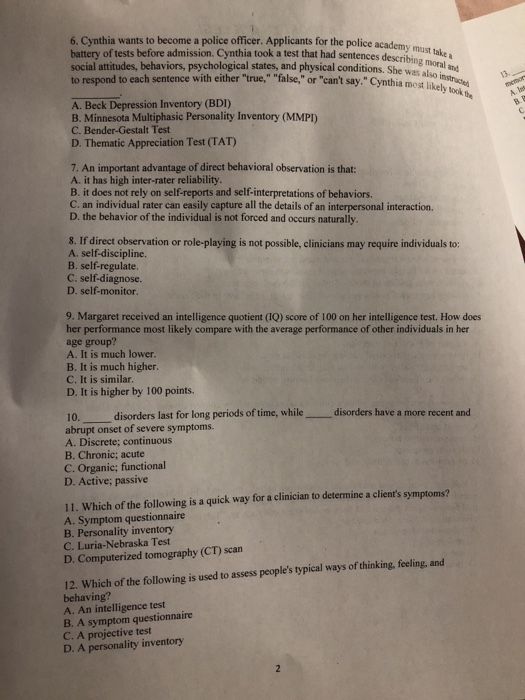

Relative risk ratio analyses showed that cutoffs of 45T and 50T maintained reasonable selection ratios because of the exceptionally low scores in this sample and were associated with significantly increased risk for problematic behavior. After applying a correction for range restriction, MMPI-2-RF substantive scales demonstrated moderate to strong associations with criteria, particularly in the Emotional Dysfunction and Interpersonal Functioning domains. The sample produced meaningfully lower and less variant substantive scale scores than the general population and the MMPI-2-RF Police Candidate comparison group, which significantly affected effect sizes for the zero-order correlations. MMPI-2-RF scores were collected from preemployment psychological evaluations of 136 male police officers, and supervisor ratings of performance and problem behavior were subsequently obtained during the initial probationary period. Ben-Porath1Ībstract The purpose of this study was to investigate the predictive validity of the Minnesota Multiphasic Personality Inventory– 2–Restructured Form (MMPI-2-RF) in a sample of law enforcement officers. Minnesota Multiphasic Personality Inventory–2–Restructured Form (MMPI-2-RF) Predictors of Police Officer Problem BehaviorĪssessment 2015, Vol. Although additional studies are required to confirm these findings, the results argue for the increased use of the IPI, at times in combination with the MMPI-2.ASMXXX10.1177/1073191114534885AssessmentTarescavage et al. The IPI scores, however, yielded significantly higher relationships between instrument results and subsequent police performance. The findings show that both MMPI versions and the IPI provided modest correlation and effect size relationships to police behavior.
/psychological-exams-and-screening-for-police-officers-974785_final-5c0ac43ac9e77c0001f3db36.png)
An independent groups "t" test was performed to compare the mean correlation and mean effect size of the two instruments and job performance. A mean correlation and a mean effect size were calculated for the MMPI/MMPI-2 and a mean correlation and a mean effect size were calculated for the IPI. Next, the obtained correlations were transformed into effect sizes by using Friedman's (1968) formula. Pearson product-moment correlation coefficients were produced for all predictors in each study that reported a numerical relationship with the criterion. Of the studies found, 18 met the criteria. The studies selected were also required to have official departmental documentation of officer behavior and to provide statistical information on the relationship between the predictor at issue and the dependent variable that could be converted into Pearson's "r" as well as a corresponding effect size.

Research studies on the two instruments were selected from published and unpublished sources from 1980 to 2000 and focused on the prediction characteristics of the instruments. The scales contain critical items used to identify disturbed individuals as well as items that identify less pathological personality and adjustment problems. The IPI scales measure both personality characteristics and behavioral patterns. The IPI was developed specifically for application with law enforcement officers in response to criticism of the MMPI's application to officer selection. In 1989 the original MMPI was revised (MMPI-2) to improve validity and acceptability. The MMPI/MMPI-2 has been one of the most commonly used personality measures in the pre-employment test of applicants for policing.


 0 kommentar(er)
0 kommentar(er)
